NIPSS is mandated to train top policy and decision-makers in Nigeria, across both the public and private sectors.
It is also tasked with producing “leaders worth their salt” who can make sound decisions for national growth.
The delegation was led by Prof. Ayo Omotayo, the Director General of NIPSS.
Governor Sanwo-Olu, represented by his Deputy, Dr Obafemi Hamzat, noted that Lagos covers just 0.4 per cent of Nigeria’s landmass, but accommodates 11 per cent of the country’s population.
He added that one-third of the state’s land area is made up of water.
He stated: “The idea for us is we must have a transport system that utilises water and operates like it’s rail.”
Sanwo-Olu stressed the need for inter-agency collaboration, noting that conflicts with federal agencies often hamper development.
He cited the Lekki link bridge, where the National Inland Waterways Authority demanded payment to allow construction.
He also raised concerns about federal control over ports and related infrastructure within Lagos.
In other nations, ports maintain surrounding infrastructure — this, he noted, is not practised in Nigeria.
He urged NIPSS to investigate and include such issues in their final report.
“As you write those reports, I think it’s important to also bring those issues out,” he added.
The governor further outlined Lagos State’s unique rail funding model.
He said Lagos is the only sub-national entity worldwide to fund rail projects from its balance sheet.
Sanwo-Olu expressed hope that the institute’s report would offer frameworks to support national and sub-national institutions.
He welcomed the participants and encouraged them to visit key locations, such as the Lagos rail system and J.K. Randle Museum.
He described the museum as the best of its kind in Africa.
Professor Omotayo said the visit aimed to explore Lagos’s blue economy potential.
He added that the study would also expose participants to best practices in governance and development.
According to him, the theme of the study tour is ‘Blue and Marine Sustainable Economy’.
He said Lagos offers the greatest opportunities in Nigeria’s blue economy sector.
Omotayo added that the visit should yield insights that would inform national policy formulation.
“Lagos is the biggest in terms of the blue economy, which is why we returned despite visiting previously.
“We hope to understand Lagos’s progress and identify new opportunities in the blue economy sector.
“We shall examine the issues, challenges, and prospects of this important theme,” he said.
He also noted that NIPSS has conducted similar tours in several Nigerian states and 10 countries — seven in Africa, three beyond.
The final report of the tour will be presented in August, with a full panel report due to the President in December.



